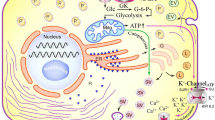Abstract—The physicochemical characteristics of erythrocyte membranes from the peripheral whole blood of rats and the erythrocytes washed with physiological solution, using the method of acid hemolysis, under diabetes mellitus conditions and against the therapy based on low-intensity blue light emission in the visible light range have been studied. The use of low-intensity light therapy (LILT) led to a decrease in the resistance of erythrocyte membranes to the action of acid hemolytic in the control group animals. Under diabetes conditions, LILT prolonged total hemolysis and reduced the count of hemolysed erythrocytes relative to the indices in the group of animals with DM. No expressed hypoglycemic effect due to the LILT was observed in sick animals, and the content of glycolysed hemoglobin tended to decrease.


Similar content being viewed by others
REFERENCES
Karandashov, V.I., Biological effects of blue light irradiation and perspectives of its application in practical medicine, Photobiol. Exp. Photomed., 2013, vol. 1, no. 2, pp. 98–106.
Stern, M., Broja, M., Sansone, R., Gröne, M., Skene, S.S., Liebmann, J., Suschek, C.V., Born, M., Kelm, M., and Heiss, C., Blue light exposure decreases systolic blood pressure, arterial stiffness, and improves endothelial function in humans, Eur. J. Prevent. Cardiol., 2017, vol. 25, pp. 1875–1883. https://doi.org/10.1177/2047487318800072
Fedorov, S.M., Bazilyuk, O.V., Korkach, Y.P., and Sagach, V.F., Magnetic-laser influence on the system of nitric oxide and contractile activity of smooth muscles of rat aorta under hypertension, Fiziol. Zh., 2012, vol. 58, no. 6, pp. 36–47. https://doi.org/10.15407/fz
Fiodorov, S.M., The modern concept of magnetic-laser and photomagnetic therapy and its use in neurological practice, Photobiol. Photomed., 2016, vol. 1, no. 2, pp. 38–50.
Serbin, M.E., Timchenko, D.S., Korobov, A.M., Laguta, T.I., and Shidlovska, O.A., Biostimulative implants and enhancement devices quality of their use, Photobiol. Photomed., 2017, vol. 1, no. 2, pp. 95–104.
KazemiKhoo, N. and Ansari, F., Blue or red: which intravascular laser light has more effects in diabetic patients? Lasers Medical Sci., 2014, vol. 30, no. 1. https://doi.org/10.1007/s10103-014-1672-7
Osinskiy, V., Pavlov, S., Tuzhanskiy, S., Kaminskiy, O., and Temchyshena, A., Laser and photonic light sources for photomedicine, Photobiol. Photomed., 2010, vol. 3, no. 4, pp. 91–97.
Popov, N.N., Malanchuk, S.G., Filimonova, N.I., Mishina, M.M., Korobov, A.M., and Liapunov, N.À., Integrated effect of photodiode emission and antiseptic drugs with disodium edetate on the daily biofilms of E. coli,Ukr. Biopharmaceut. J., 2014, vol. 5, no. 34, pp. 74–78.
Senatorova, H.S., Nikolaieva, O.V., Makieieva, N.I., Ishchenko, T.B., Riha, O.O., and Muratov, H.R., Erythropoiesis in Children in Normal and Pathological Conditions, KhNMU, 2010.
Sybirna, N.O., Burda, V.A., and Chajka, Ya.P., Methods of Blood System Research, Lviv: Lviv. Nats. Univ., 2006.
Drabkin, D.L., The crystallographic and optical properties of the hemoglobin of man in comparison with those of other species, J. Biol. Chem., 1946, vol. 164, no. 2, pp. 703–723.
Shevchuk, V.H., Moroz, V.M., Belan, S.M., Hzhehotskyi, M.R., and Yoltukhivskyi, M.V., Physiology, Vinnytsia: Nova Knyha, 2015.
Grossweiner, L.I., Fernandez, J.M., and Bilgin, M.D., Photosensitisation of red blood cell haemolysis by photodynamic agents, Lasers Med. Sci., 1998, vol. 13, pp. 42–54.
Eberlein-König, B., Placzek, M., and Przybilla, B., Phototoxic lysis of erythrocytes from humans is reduced after oral intake of ascorbic acid and alpha-tocopherol, Photodermatol. Photoimmunol. Photomed., 1997, vol. 13, no. 5–6, pp. 173–177.
Masalunga, C., Cruz, M., Porter, B., Roseff, S., Chui, B., and Mainali, E., Increased hemolysis from saline pre-washing RBCs or centrifugal pumps in neonatal ECMO, J. Perinatol., 2007, vol. 27, no. 6, pp. 380–384.
Kriventsev, Yu.A., Biochemistry: Structure and Role of Hemoglobin Profile Proteins, Moscow: Yurait, 2018.
Schmidt, A., Refaai, M., Kirkley, S., and Blumberg, N., Proven and potential clinical benefits of washing red blood cells before transfusion: current perspectives, Int. J. Clin. Transfus. Med., 2016, vol. 4, pp. 79–88. https://doi.org/10.2147/IJCTM.S101401
Lu, M., Lezzar, D.L., Vörös, E., and Shevkoplyas, S.S., Traditional and emerging technologies for washing and volume reducing blood products. J. Blood. Med., 2019, vol. 10, pp. 37–46. https://doi.org/10.2147/JBM.S166316
Author information
Authors and Affiliations
Corresponding author
Ethics declarations
FUNDING
This study did not receive any particular grant from financial organizations in the state, commercial or noncommercial sectors.
COMPLIANCE WITH ETHICAL STANDARDS
Conflict of interest. The authors declare that they have no conflict of interest.
Statement on the welfare of animals. The studies were based on an animal model with the observance of all norms of bioethics in working with laboratory animals.
Additional information
Translated by N. Tarasyuk
About this article
Cite this article
Yefimenko, N., Liuta, M., Karmash, O. et al. Effect of Low-Intensity Blue Light Emission on Physicochemical Properties of Blood Erythrocytes in Rats under Diabetes Mellitus Conditions. Cytol. Genet. 54, 449–455 (2020). https://doi.org/10.3103/S0095452720050102
Received:
Revised:
Accepted:
Published:
Issue Date:
DOI: https://doi.org/10.3103/S0095452720050102




